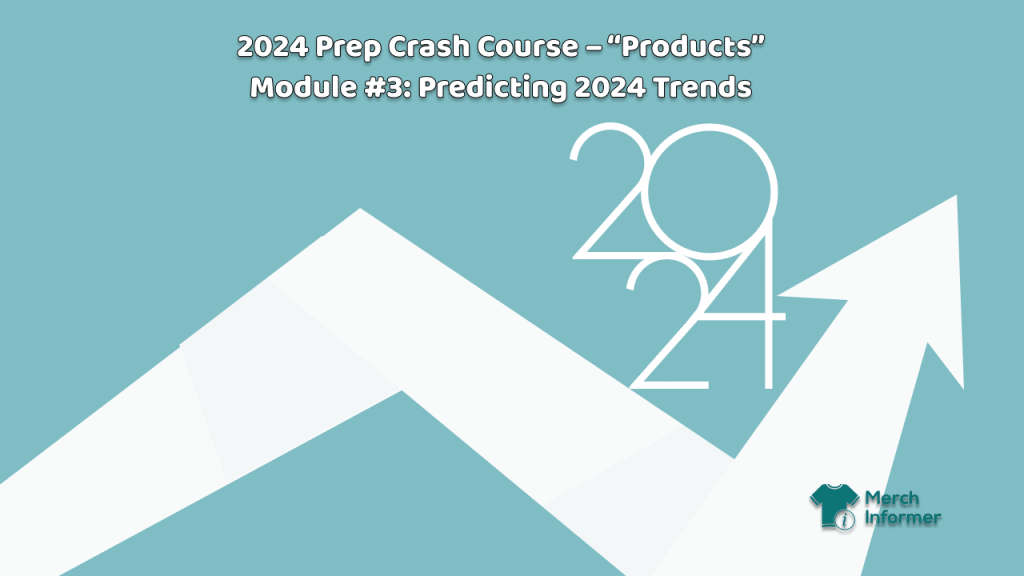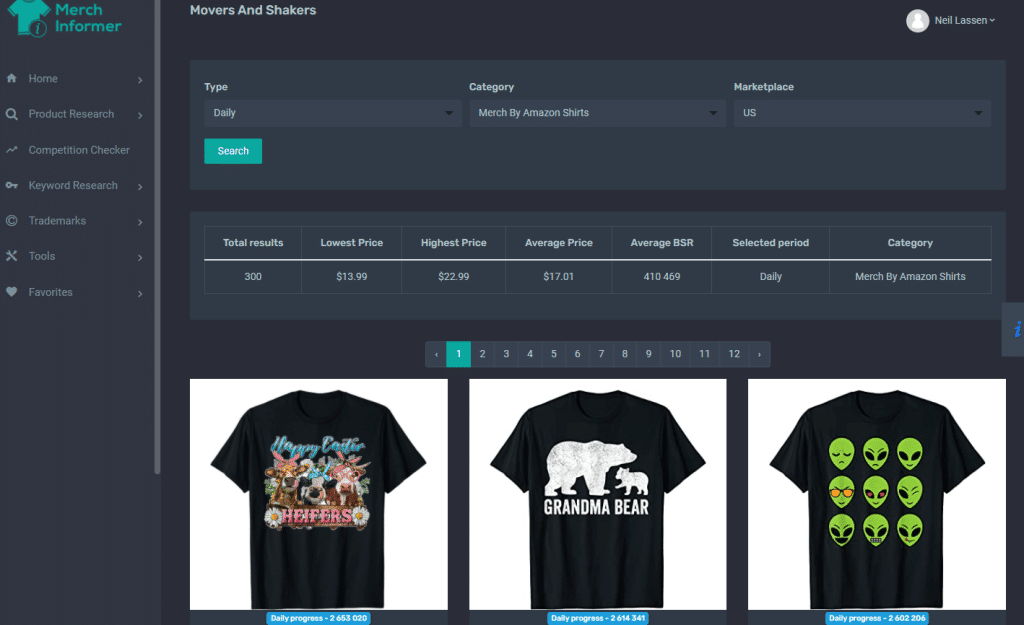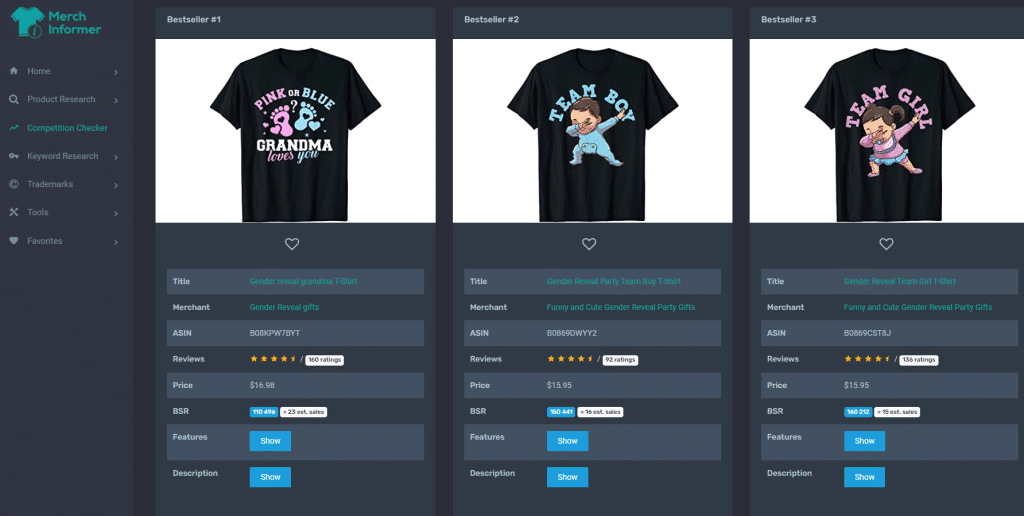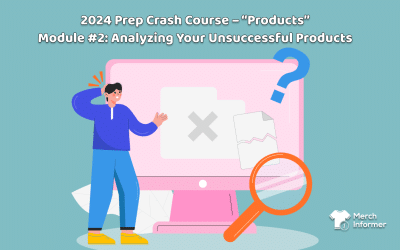2024 Prep Crash Course – “Products” Module #3: Predicting 2024 Trends
In our third installment of “Projects,” we look at the strategies and insights that MBA merchants can use to forecast sales trends.
As with our previous entry, take a moment to step back and take a deep breath before proceeding with the next phase of Product Development. Consider what you achieved in 2023. You had victories. You suffered setbacks. Each of them is the foundation upon which you will build your 2024 (and beyond!) product lines.
This week, we will set aside our data but keep it in our minds.
Looking at expert trend predictions and determining whether their insights are good for your products and, by extension, your company is part of how we make decisions about what products we create for 2024. The over/underperforming data we pulled in our previous entry is important because it helps you develop a reflex, a gut feeling that will help you make better decisions when looking at future trend predictions.
All that said, trust your gut.
PREDICTING SALES TRENDS
Market Research: A Foundation for Success
The cornerstone of predicting sales trends in Merch by Amazon lies in comprehensive market research. Delve into consumer preferences and emerging fashion trends. This includes understanding style preferences, color choices, and the evolving tastes of your target audience. A multi-faceted approach to market research can provide invaluable insights.
Consumer Behavior Analysis: Insight into Trends
Consumer behavior analysis is an essential aspect of forecasting trends. It involves examining consumer fashion choices, style preferences, and buying habits. Understanding how consumers interact with fashion and apparel provides insights into patterns and preferences within the target audience.
As you would expect, MerchInformer has already built Trend Hunter, a tool that can help analyze and identify trends. For a step-by-step guide on how to use Trend Hunter, read all about it here.
ANALYZING HISTORICAL DATA
Sales Data Analysis: A Valuable Resource
Historical sales data serves as a treasure trove of information. By analyzing which types of apparel and accessories have consistently performed well in the past, you can identify categories and designs that are likely to continue selling. For example, if retro-inspired t-shirts or eco-friendly accessories have consistently shown strong sales, it’s a hint at the type of products consumers are interested in.
Seasonal Variations: Anticipating Market Fluctuations
It’s important to recognize that sales trends can be seasonal in categories like apparel and accessories. For instance, summer clothing may experience a surge in demand during the warmer months. At the risk of stating the obvious, anticipate these seasonal variations, adapt their product lineup accordingly, and offer items that cater to different seasons and occasions.
My recommendation for seasonal approaches is twofold:
Offer a twist on the holiday, targeting young/alts raised in that tradition
Offer a contemporary, non-traditional approach to an underserved holiday.
Unless you have hard data on a specific seasonal niche, this two front approach is your best way to stand out in a crowded market and therefore more saleable.
EMERGING MARKET TRENDS
Identifying Market Gaps: Exploring Opportunities
The world of fashion is dynamic, with trends and consumer preferences evolving continually. Forecast sales trends by identifying market gaps or emerging niches within the fashion industry. If there’s an underserved audience looking for specific styles or designs, it presents an opportunity to create customized products. By anticipating these market shifts, you can proactively meet consumer demands.
Consumer Preferences: Staying Ahead of the Curve
Consumer preferences in fashion are influenced by various factors, including cultural shifts, design trends, and societal changes. Stay attuned to evolving consumer preferences, style trends, and design aesthetics. This can involve conducting surveys, focus groups, or social media polls to gain direct insights from the target audience. Understanding design styles, fabric choices, and other factors that resonate with consumers is paramount.
COMPETITIVE ANALYSIS
Assessing Competitor Strategies: A Source of Inspiration
Successful competitors can provide valuable insights into what will sell in the coming year. By assessing what these competitors are doing differently, you can identify their strengths and areas where their own product lineup can outperform. This analysis isn’t about copying competitors but rather finding inspiration and areas for differentiation.
Pricing and Positioning: Standing Out in the Market
Competitive analysis should also encompass pricing strategies and product positioning. By evaluating how competitors price their products and where they position themselves in the market, you can determine how your own products can stand out in terms of quality, style, and appeal. Understanding the competitive landscape is a critical component of forecasting sales trends.
In our last entry, we mentioned MerchInformer’s robust Competitor Anazlysis Tool, which you can find here.
PROACTIVE PLANNING
Product Lineup Strategy: Balancing Tradition and Innovation
Armed with insights from market research, historical data, emerging trends, and competitive analysis, you can develop a strategic product lineup for the coming year. This lineup should carefully balance products that have enduring appeal and those that tap into emerging fashion trends. For example, classic designs like timeless graphic t-shirts can coexist with innovative designs that reflect current style trends.
Marketing and Promotion: Aligning with Trends
The forecasting process extends beyond product creation to marketing and promotion. To be safe, plan your marketing and promotional strategies in alignment with forecasted trends. This includes leveraging digital advertising, social media campaigns, and content that reflects current fashion trends to promote products effectively.
DON’T BE AFRAID TO USE YOUR GUT
In the ever-evolving landscape of fashion and style, the ability to predict sales trends is a valuable skill that can significantly impact your success. By conducting comprehensive market research, analyzing historical sales data, identifying emerging fashion trends, and assessing competitor strategies, you can gain the insights needed to forecast what will sell in the coming year.
This proactive approach can enable you to adapt your product lineup to meet consumer demands and stay ahead of the curve. While the fashion industry may continually evolve, those who leverage these strategies will find themselves better positioned to meet the needs and preferences of their target audience.
So, once you’ve got all this data to guide you, you still need to trust your instincts. Let the data inform you, but let your instincts direct you. There is only so much science can predict; the rest is what made you successful to begin with: your ideas, your interpretation of trends.
In the words of fashion icon Coco Chanel, “Fashion is not something that exists in dresses only. Fashion is in the sky, in the street; fashion has to do with ideas, the way we live, what is happening.” By applying these strategies, Merch by Amazon producers can craft a future of success in fashion by aligning their product offerings with the ever-changing desires of style-conscious consumers.







